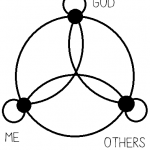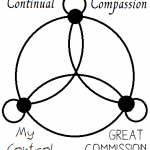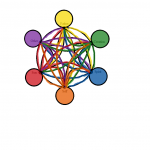Of late, I have been pondering the mystery of “perichoresis.”
Now, I first encountered this idea in Brian McLaren’s A Generous Orthodoxy, which I read in my junior year of high school. Here is how he explains perichoresis, speaking especially in regard to the Eastern Orthodox Church:
I learned that the early church leaders described the Trinity using the term perichoresis ( peri —circle, choresis –dance): the Trinity was an eternal dance of Father, Son, and Spirit sharing mutual love, honor, happiness, joy, and respect. Against this backdrop, God’s act of creation means that God is inviting more and more beings into the eternal dance of joy. Sin means that people are stepping out of the dance, corrupting its beauty and rhythm, crashing and tackling and stomping on feet instead of moving with grace , rhythm, and reverence. Then, in Jesus, God enters creation to restore the rhythm a nd beauty again. – A Generous Orthodoxy- Brian McLaren- Pages 23-24Now to be fair, this isn’t a truly proper xplanation. Just because a word has a certain root or original definition doesn’t mean that the word means exactly that. For example, “courage” comes from the root “cor” which means “heart”– so there might have been a connection in the beginning, but when people say “courage” they don’t automatically connect it to the heart.
So from Merriam-Webster we get the definition “a doctrine of the reciprocal inherence of the human and divine natures of Christ in each other.” According to Wikipedia, “Gregory [of Nazianzus] used it to describe the relationship between the divine and human natures of Christ as did John of Damascus, but he also extended it to the ‘interpenetration’ of the three persons of the Trinity and it became a technical term for the later.” And at theopedia.com, we get this:
“Perichoresis is a Greek term used to describe the triune relationship between each person of the Godhead. It can be defined as co-indwelling, co-inhering, and mutual interpenetration. Alister McGrath writes that it “allows the individuality of the persons to be maintained, while insisting that each person shares in the life of the other two. An image often used to express this idea is that of a ‘community of being,’ in which each person, while maintaining its distinctive identity, penetrates the others and is penetrated by them.”
My interest in this idea came up again while reading a book for my Children’s Ministry course here at Wheaton. Children Matter is by a number of authors, including my professor Scottie May. In a chapter going over the different models of understanding a child’s faith, I found this model: the Dance with God Model. It’s defined as “a metaphor [that] represents a relational model– the relationship of the child ‘with the living God– enacted in this world.‘” (Children Matter, 19). In fact, the idea comes from Walter Wangerin’s book, Orphean Passages (which I just purchased on Amazon!). This quote from the book is quite elegant and though provoking:
Who can say when, in a child, the dance with God begins? No one. Not even the child can later look back and remember the beginning of it, because it is as natural an experience (as early and as universally received) as the child’s relationship with the sun or with his bedroom. And the beginning, specifically, cannot be remembered because in the beginning there are no words for it. The language to name, contain, and to explain the experience comes afterward. The dance, then, the relationship with God, faithing, begins in a mist.
Cool huh?
Now, I have to confess something: I really don’t like to dance. You’d think with all this dance imagery that I was a regular ballroom dancing, rhythmic moving kind of guy. But no. Sure I can do the Cupid Shuffle or participate in Sing or dance goofy when I want to, but I’m really not that coordinated nor do I really take joy in dancing with others.
But there’s something that appeals to me about this idea. I believe it’s the essence of harmony in both of these concepts. The harmony of the Trinity and the harmony of the human relationship with God. Natural, flowing, smooth, peaceful.
Maybe you’re more of a music or literary person? How does this analogy work for you?
In the Lord of the Rings Universe, the Creator was named Eru Ilúvatar (Father of All). After creating the Ainur “Holy Ones” he teaches them the art of “Music.” Their job is to sing along with Eru, each contributing their own unique compositions. “Heaven becomes filled with the making of Music… these creative musical elaborations only gradually, through exposure to eachother, become collaborative… Through listening and contemplation, an Ainu becomes aware of other Ainur, other musics, and the cultivation and adornment of other themes.” The Ainur sing and compose music, beautiful music. But then, Melkor, the most powerful of the Ainur, sings in dischordant tones, breaking up the harmony of the Music and causing havoc in Heaven. (taken from http://lotr.wikia.com/wiki/Ainulindal%C3%AB)
Sound familiar?
Also in The Chornicles of Narnia, how does CS Lewis describe creation of Narnia?
In the darkness, something was happening at last. A voice had begun to sing. It was very far away and Digory found it hard to decide from what direction it was coming. Sometimes it seemed to come from all directions at once. Sometimes he almost thought it was coming out of the earth beneath them. Its lower notes were deep enough to be the voice of the earth herself. There were no words. There was hardly even a tune. But it was, beyond comparison, the most beautiful noise he had ever heard. It was so beautiful he could hardly bear it . . . Then two wonders happened at the same moment. One was that the voice was suddenly joined by other voices; more voices than you could possibly count. They were in harmony with it, but far higher up the scale; cold, tingling, silvery voices. The second wonder was that the blackness overhead, all at once, was blazing with stars. They didn’t come out gently one by one as on a summer evening. One moment there had been nothing but darkness; next moment a thousand, thousand points of light leaped out . . . If you had seen and heard it, as Digory did, you would have felt quite certain that it was the First Voice, the deep one, which had made them appear and made them sing. –C.S. Lewis, The Magician’s Nephew, Pages 98-99)
And as this music swells and grows, creation emerges from the song and joins in.
Dance. Harmony. Music. Creation. Unity.
It pulls at me, a desire to join in the dance, to sing along with the Voice of Love. All the while, a million little hands pull me in other directions, pull me out of harmony with the Love of God. I want to be with God and I don’t, all at the same time. The Glory of Being Human. A lifelong struggle.
For a few weeks, I couldn’t stop drawing these images. Not in like a “Oh no, he’s stuck in a trance!” way, but more “I can’t stop thinking about this” way. My notebooks have so many of these images in the margins, and I finally tried making some using modern technology: Microsoft Paint!
None of these images fully describe the Trinity’s relationships or our relationship with God, but they’re something, mere attempts to capture the Divine. What do you think?
In my Philosophy of Ministry course last semester, I was to write a mission statement of sorts for my ministry and my life. My idea was this: “Participating in the Love of God.” Here’s a sample from what I wrote in my paper:
As I participate in the Trinity, I invite others to join in and God’s family and the dance of love grows and grows, bringing more and more love and glory to God. [Lois] Lebar writes about the importance of Christians living lives of joy that reflect God’s love: “If Life Himself is pulsing through every never and the eternal Creator is manifesting Himself in us, how can life be drull and drab?” (Lebar 222). We are to live full lives of glory to God. In the end, this is the ultimate end, bringing glory to God; however, participating in God’s love is not a means to that end, but merely another way of looking at or describing that end. Participating in God’s love does not cause glory to God, it is the act of glory to God, for more and more people come to know Him and love Him and His fame and adoration grows and grows. This is my ultimate aim.
I am still growing in this idea. I’m sure some of these ideas I’ve written down (or doodled) are incorrect, but I’m still learning. I’m hoping to read The Orphean Passages soon, do more research on Perichoresis, look into the works of C Baxter Kruger and others, and do more drawings. Though I’ll never fully grasp the idea of our relationship with God, God gives me the grace to participate. Just as a baby has no understanding of the lungs but still is able to breathe in and out, naturally, my only hope is to become more and more natural and see myself in the “dance of God.”






